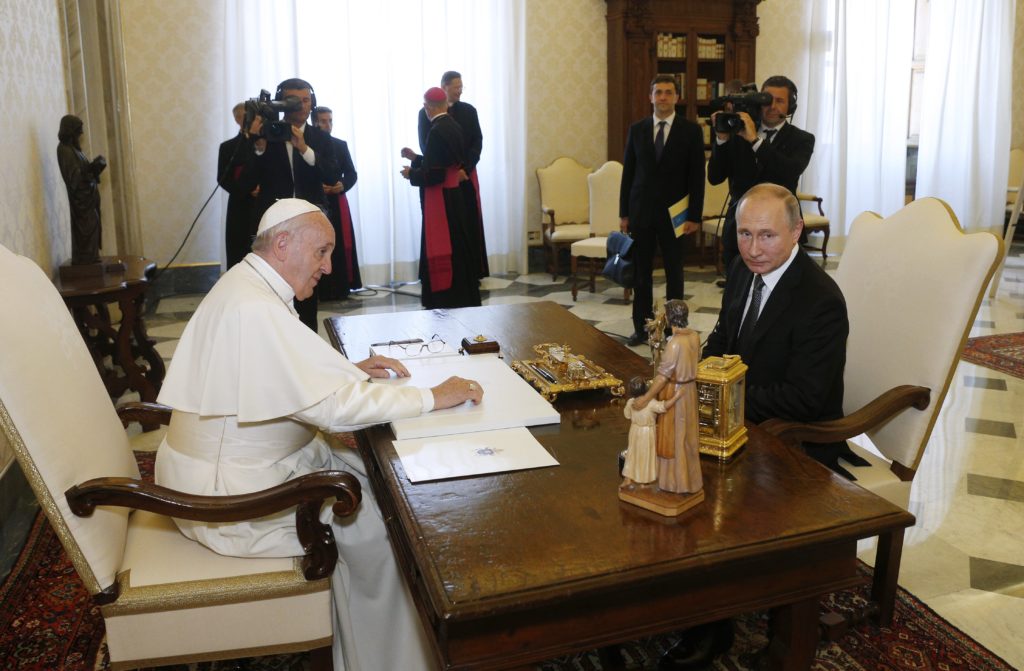As winter approaches, experts expect the Russian-Ukrainian War to slow down, due to the cold weather’s effect on both troops and machines.
A pause would give both sides time to build up defenses and train, but many hope it will also represent an opportunity for diplomacy to work.
Since the conflict began, the Vatican has offered to mediate between the two sides, but the offer has so far been rebuffed: Will the expected pause in heavy combat mean that the pope could emerge as a peacemaker?
There is hope a breakthrough could be on the horizon. On Oct. 25, a spokesman for President Vladimir Putin suggested Russia is open to peace talks with Pope Francis himself, as well as with the governments of the U.S. and France.
It wouldn’t be the first time the pope has engaged in international peace work. He was instrumental in helping the U.S. and Cuba re-establish diplomatic relations and played an important role in preventing a Western military intervention in Syria in 2013. In 2019, he brought the warring leaders of South Sudan to the Vatican to pledge to end that young country’s civil war.
The Holy Father has certainly embraced his role as “Pontifex”— that is, “bridge builder.” But there are fears the Russia-Ukraine conflict may be a bridge too far.
Much of this is of the pope’s own doing. His off-the-cuff remarks on the conflict have angered many Ukrainians, since Pope Francis has implied that Putin had reason to be aggrieved by “NATO barking at Russia’s door,” meaning its post-Cold War expansion into Eastern Europe, and said there are “no metaphysical good guys and bad guys” in the conflict.
The situation reached a boiling point in August, when Pope Francis referenced the car bombing death of Darya Dugina, the daughter of a prominent Russian ultra-nationalist philosopher.
Speaking during his general audience, Pope Francis called her “a poor girl” and an “innocent,” despite her strong support of the Russian invasion and her political activity independent of her father.
In a rare diplomatic move, the Ukrainian foreign ministry summoned the Vatican ambassador to express its “disappointment” over the pope’s words.
In addition to irritating the Ukrainians, Pope Francis also upset Russian Patriarch Kirill by telling him to not be “Putin’s altar boy” during a teleconference between the two religious leaders.
Patriarch Kirill has been a staunch supporter of Putin’s invasion, going as far as telling Russian troops they will go to heaven if they die in Ukraine. There has been a religious undercurrent to the Ukrainian crisis as well, with the dominant Orthodox Church divided between those who are under the patriarch and those in an independent Orthodox Church recognized by the Patriarch of Constantinople. Since the invasion, many parishes in the Moscow-affiliated church have broken ties with Patriarch Kirill due to his embrace of the invasion.
The Vatican has long been accused of tiptoeing around Russia’s culpability in the war to not damage its relations with the Moscow Patriarchate.
Yet these papal faux pas and ecumenical concerns aren’t the main reason it’s hard to envision the Holy See playing a role in forging a cease-fire in Ukraine.
The fact is that neither side is willing to compromise at the moment. Ukraine has suffered greatly in the war, including the horrible scenes of war crimes in liberated territories, and is determined to oust the invader. In addition, they remember the experience of the First Chechen War in the 1990s, when Russia made a peace deal only to rearm and reinvade shortly thereafter. And given recent military successes, the Ukrainians don’t want to give Russia a breather while they’re seemingly ahead.
Russia has also recently begun the mobilization of hundreds of thousands of troops, and state media continues to refer to the Ukrainian government as illegitimate, even questioning the right of Ukraine to exist as an independent state. At the beginning of the war, the Russians spoke about “denazifying” Ukraine; now they speak about “de-satanizing” the country. It is not the rhetoric of a country seeking peaceful coexistence.
There is no real common ground between the parties to negotiate a ceasefire, let alone a peace treaty.
The Vatican’s Ukraine policy does, however, shine a light on a trend in Vatican diplomacy returning to the “Ostpolitik” (“Eastern Policy”) policy practiced by Pope John XXIII and Pope Paul VI, where the Holy See mostly abandoned the confrontational attitude of Pope Pius XII toward oppressive Communist regimes in Eastern Europe. This policy ended with the election of the Polish Pope John Paul II, whose full-throated defense of freedom and democracy helped bring down the Iron Curtain in 1989.
The Holy See hasn’t only been slow to name Russia an aggressor. It has also been notably restrained in the face of government repression of the Catholic Church in Nicaragua. It has stopped short of condemning the recent arrest of Bishop Rolando Álvarez, calling rather for an “open and sincere” dialogue in the country.
In China, the Vatican has come under criticism from members of the U.S. Commission on International Religious Freedom for its deal with the People’s Republic of China on the appointment of bishops and its silence over the trial of Cardinal Joseph Zen in Hong Kong, who is accused of illegally funding the defense of pro-democracy activists.
Pope Francis has embraced his role as “Pontifex,” but to build on his earlier successes, he might have to find a new way to construct a bridge.

